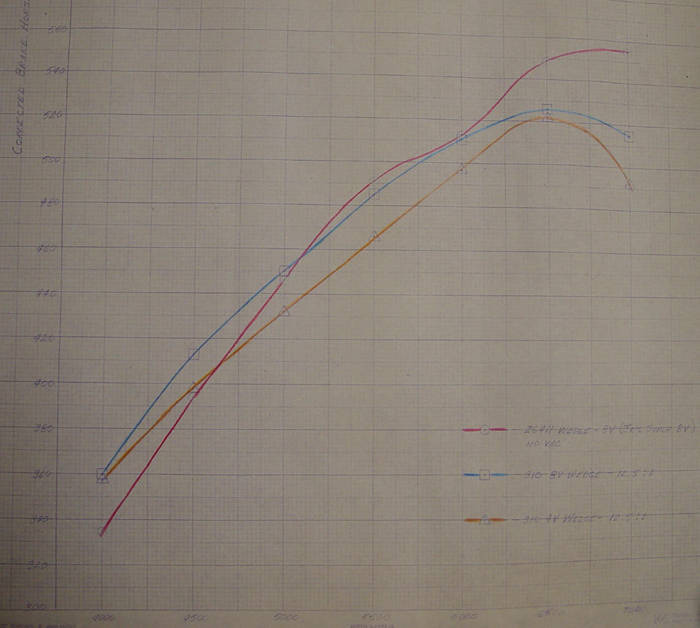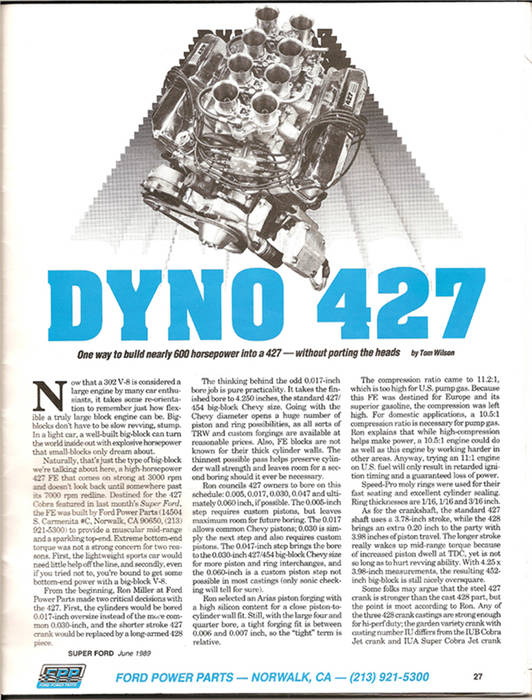Quote:
Originally Posted by Cobra #3170

I will undoubtably regret this but:
600 hp with Webers on a 427 in the 60's "the impossible dream"
Every dyno sheet I have ever seen and I have looked at quite a few show maximum power in the 550 range and that was a 427 Tunnel Port with 15 to 1 pistons with Daytona cam and dual 4 barrels on a single plane manifold. Certainly not a road race set up. The dyno sheets were from the Dearborn engine lab and thus accurate, as compared to other less reliable sources.
How did you get to 2150 for a Cobra with an all aluminum 390 vs a Cobra with a 427 iron block high riser probably more like 2250.
|
Bruce, it seems whatever evidence anyone provides will not change your mind on things, but I’ll give this a shot. I may not have enough time to get into every detail, but the 600hp number is based on dyno testing, similar engine configurations and analysis. This also ignores the fact that the weber engine will make significantly more mid range torque than any of the Holley setups.
First, the following baseline dyno results from Ford's Engine and Foundry division show the 427 high riser 2x4 in top tune as having generated about 550hp. This work was done during the SOHC development period, as there are other graphs where the red curve was plotted against the various SOHC results for comparison.

Next, these results were duplicated/correlated with modern dyno testing done by the owner of CSX3191. His engine just had a bigger cam (around 270 deg duration) than was available back when the Ford testing was done, so he achieved 558 HP with the C4AE-F 2x4 intake and 569 HP with the taller C3AE-D 2x4 intake. The 58mm weber induction was then installed and tuned and he was ultimately able to achieve 600hp, which was documented in this article:

The cam in my engine is slightly less radical than the one in this testing, mine essentially falling in between the factory grinds SK38427 and SK42390, but with less overlap to minimize weber reversion. However, my engine has other period original power enhancing attributes, like the traditional longitudinal carb mount intake manifold with straighter, shorter more direct ports, shorter velocity stacks and slightly larger chokes, all for more top end tuning and peak HP, factory dry sump, better combustion chamber design of the factory aluminum HR race head, roller cam (used by SA on their top race engines) and original Shelby American works porting (relatively mild). As you may remember, a friend who works for one of the leading F1 teams also modeled my engine on their software, which predicted just over 600hp.
In addition, David Salkowski, who occasionally posts on this forum, has a modern Shelby aluminum engine at a higher state of tune with reproduction Berg 58mm webers and he has many dyno runs showing about 735 HP. David’s engine uses ported Edelbrock heads (ie, more cylinder head flow), a bigger cam and higher compression, but a similar layout intake to mine and the similarity makes sense that mine would probably be within about 100 HP of his. Also, I don't know if you ever met Jim O'Leary, but he was an engine builder at Shelby American in the 60's. He said that they were getting 635 HP out of the tunnel port engines with the IR injection that they were running in the Can Am cars. My heads flow within about 15 cfm of the tunnel ports and Ford's Indy car program in the 60's documented that when they replaced the 58mm webers with the fuel injection they had available at the time the HP didn't change, just fuel economy went up. At some point I may have mine dyno’d, but in the mean time all the evidence is quite overwhelming supporting the 600 HP.
The 2150 lb weight came from the comp car specifications sheet that Shelby American released in ’65. I’ve been a little skeptical of that number, but I’ve been able to come up with a weight more around 2250 lb for my car with the all aluminum works race engine by subtracting individual component weight deltas from the standard street car value (incl magnesium wheel savings, etc), so I figured a few more pounds could be found here or there (remove heater, etc, etc). Either way, it’s in the ballpark.